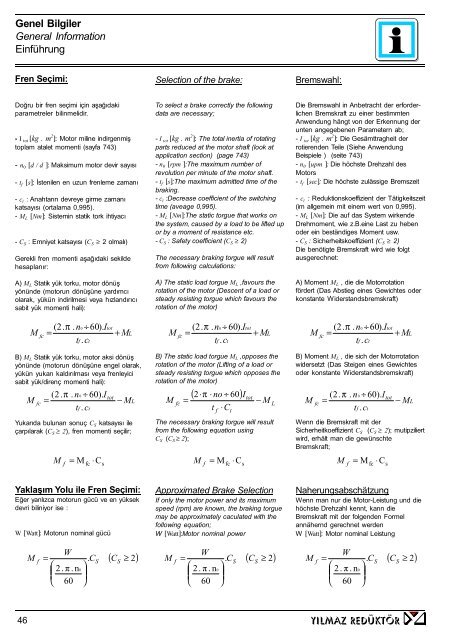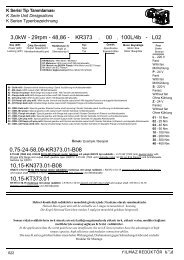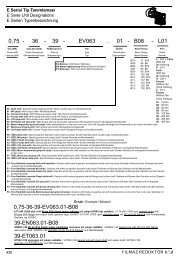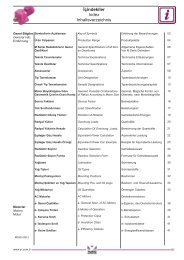Sie wollen auch ein ePaper? Erhöhen Sie die Reichweite Ihrer Titel.
YUMPU macht aus Druck-PDFs automatisch weboptimierte ePaper, die Google liebt.
Genel Bilgiler<br />
General Information<br />
Einführung<br />
Fren Seçimi:<br />
Doğru bir fren seçimi için aşağıdaki<br />
parametreler bilinmelidir.<br />
- I tot [kg . m 2 ]: Motor miline indirgenmiş<br />
toplam atalet momenti (sayfa 743)<br />
- n 0 [d / d ]: Maksimum motor devir sayısı<br />
- t f [s]: İstenilen en uzun frenleme zamanı<br />
- c t : Anahtarın devreye girme zamanı<br />
katsayısı (ortalama 0,995).<br />
- M L [Nm]: Sistemin statik tork ihtiyacı<br />
- C S : Emniyet katsayısı (C S ‡ 2 olmalı)<br />
Gerekli fren momenti aşağıdaki sekilde<br />
hesaplanır:<br />
A) M L Statik yük torku, motor dönüş<br />
yönünde (motorun dönüşüne yardımcı<br />
olarak, yükün indirilmesi veya hızlandırıcı<br />
sabit yük momenti hali):<br />
B) M L Statik yük torku, motor aksi dönüş<br />
yönünde (motorun dönüşüne engel olarak,<br />
yükün yukarı kaldırılması veya frenleyici<br />
sabit yük/direnç momenti hali):<br />
Yukarıda bulunan sonuç C S katsayısı ile<br />
çarpılarak (C S ‡ 2), fren momenti seçilir;<br />
Yaklaşım Yolu ile Fren Seçimi:<br />
Eğer yanlızca motorun gücü ve en yüksek<br />
devri biliniyor ise :<br />
W [Watt]: Motorun nominal gücü<br />
46<br />
M<br />
M<br />
M<br />
f c<br />
fc<br />
=<br />
=<br />
( 2.<br />
π . n0<br />
÷ 60).<br />
I<br />
tf<br />
. ct<br />
( 2.<br />
π . n0<br />
÷ 60).<br />
I<br />
tf.<br />
ct<br />
tot<br />
tot<br />
+ M<br />
L<br />
− M<br />
L<br />
Selection of the brake:<br />
To select a brake correctly the following<br />
data are necessary;<br />
- I tot [kg . m 2 ]: The total inertia of rotating<br />
parts reduced at the motor shaft (look at<br />
application section) (page 743)<br />
- n 0 [rpm ]:The maximum number of<br />
revolution per minute of the motor shaft.<br />
- t f [s]:The maximum admitted time of the<br />
braking.<br />
- c t :Decrease coefficient of the switching<br />
time (aveage 0,995).<br />
- M L [Nm]:The static torgue that works on<br />
the system, caused by a load to be lifted up<br />
or by a moment of resistance etc.<br />
- C S : Safety coefficient (C S ‡ 2)<br />
The necessary braking torgue will result<br />
from following calculations:<br />
A) The static load torgue M L ,favours the<br />
rotation of the motor (Descent of a load or<br />
steady resisting torgue which favours the<br />
rotation of the motor)<br />
B) The static load torgue M L ,opposes the<br />
rotation of the motor (Lifting of a load or<br />
steady resisting torgue which opposes the<br />
rotation of the motor)<br />
( 2⋅π ⋅ no ÷ 60)<br />
tot<br />
M fc =<br />
−<br />
t f ⋅Ct<br />
The necessary braking torgue will result<br />
from the following equation using<br />
C S (C S ‡ 2);<br />
Approximated Brake Selection<br />
If only the motor power and its maximum<br />
speed (rpm) are known, the braking torgue<br />
may be approximately caculated with the<br />
following equation;<br />
W [Watt]:Motor nominal power<br />
Bremswahl:<br />
Die Bremswahl in Anbetracht der erforderlichen<br />
Bremskraft zu einer bestimmten<br />
Anwendung hängt von der Erkennung der<br />
unten angegebenen Parametern ab;<br />
- I tot [kg . m 2 ]: Die Gesämttragheit der<br />
rotierenden Teile (Siehe Anwendung<br />
Beispiele ) (seite 743)<br />
- n 0 [upm ]: Die höchste Drehzahl des<br />
Motors<br />
- t f [sec]: Die höchste zulässige Bremszeit<br />
- c t : Reduktionskoeffizient der Tätigkeitszeit<br />
(im allgemein mit einem wert von 0,995).<br />
- M L [Nm]: Die auf das System wirkende<br />
Drehmoment, wie z.B.eine Last zu heben<br />
oder ein beständiges Moment usw.<br />
- C S : Sicherheitskoeffizient (C S ‡ 2)<br />
Die benötigte Bremskraft wird wie folgt<br />
ausgerechnet:<br />
A) Moment M L , die die Motorrotation<br />
fördert (Das Abstieg eines Gewichtes oder<br />
konstante Widerstandsbremskraft)<br />
B) Moment M L , die sich der Motorrotation<br />
widersetzt (Das Steigen eines Gewichtes<br />
oder konstante Widerstandsbremskraft)<br />
Wenn die Bremskraft mit der<br />
Sicherheitkoeffizient C S (C S ‡ 2); mutipziliert<br />
wird, erhält man die gewünschte<br />
Bremskraft;<br />
fc s C M ⋅ =<br />
fc s<br />
M f<br />
C M ⋅ = M f<br />
fc s C M ⋅ = M f<br />
W<br />
. C<br />
⎛ 2.<br />
π . n ⎞ 0 ⎜ ⎟<br />
⎜ ⎟<br />
⎝ 60 ⎠<br />
f = S S<br />
( C ≥ 2)<br />
M<br />
M<br />
f c<br />
=<br />
( 2.<br />
π . n0<br />
÷ 60).<br />
I<br />
tf<br />
. ct<br />
W<br />
. C<br />
⎛ 2.<br />
π . n ⎞ 0 ⎜ ⎟<br />
⎜ ⎟<br />
⎝ 60 ⎠<br />
f = S S<br />
I<br />
tot<br />
+ M<br />
L<br />
M<br />
L<br />
( C ≥ 2)<br />
M<br />
Naherungsabschätzung<br />
Wenn man nur die Motor-Leistung und die<br />
höchste Drehzahl kennt, kann die<br />
Bremskraft mit der folgenden Formel<br />
annähernd gerechnet werden<br />
W [Watt]: Motor nominal Leistung<br />
M<br />
M<br />
fc<br />
f c<br />
=<br />
( 2.<br />
π<br />
. n0<br />
÷ 60).<br />
I<br />
=<br />
tf<br />
. ct<br />
( 2.<br />
π . n0<br />
÷ 60).<br />
I<br />
tf<br />
. ct<br />
W<br />
. C<br />
⎛ 2.<br />
π . n ⎞ 0 ⎜ ⎟<br />
⎜ ⎟<br />
⎝ 60 ⎠<br />
tot<br />
tot<br />
f = S S<br />
yilmaz redÜktÖr<br />
+ M<br />
L<br />
− M<br />
L<br />
( C ≥ 2)





